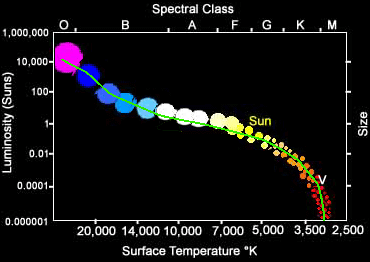Starlight - Main Sequence - O - B - A - F - G - K - M - Luminosity Classes - Spectral Class Codes
| Ia-0 | The most luminous stars known |
| Ia | Luminous Supergiants |
| Ib | Luminous Supergiants |
| II | Bright Giants |
| III | Giants |
| IV | Subgiants |
| V | Main Sequence Stars |
| VI | Subdwarfs |
| D or VII | White Dwarfs |

| Star | Code | Classification | Details |
| Barnard's Star | M5V | Main Sequence Red Dwarf | A small star, fusing hydrogen in its core and radiating with less than one percent of the Sun's luminosity. |
| Gamma Crucis | M3.5III | Red Giant | A star whose atmosphere has swelled enormously because it is fusing helium. It is radiating with the luminosity of 1,300 suns. | Betelgeuse | M2Iab | Red Supergiant | A massive supergiant that has exhausted its hydrogen and is now fusing helium. It has swelled beyond the size of the orbit of Mars. It is radiating with the luminosity of 59,000 suns. Betelgeuse is thought to be in the closing stages of its short, 10 million year life. It will explode as a Type II supernova any time in the next million years. |